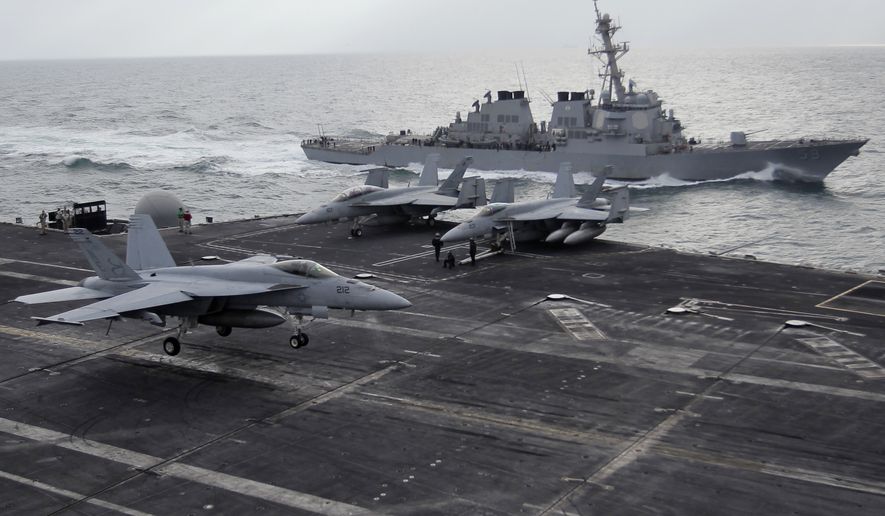How the Iranian navy’s new tactics are puzzling Pentagon
By Carlo Muñoz - The Washington Times - Wednesday, May 2, 2018
Iran’s once-aggressive navy is lying low in critical sea lanes around the Persian Gulf, and top U.S. military leaders are not sure why.
American warships operating in the waterways near the Iranian coastline have routinely been harassed by Tehran’s naval forces in recent years. Tensions came to a head after the capture and brief detention of 10 American sailors who mistakenly entered Iranian waters in January 2016.
But the sea lanes in and around the Strait of Hormuz have been relatively calm for U.S. vessels over the past six months, Adm. John Richardson, chief of naval operations, told reporters Wednesday, although antagonism between Washington and Tehran is ratcheting up on virtually every other front.
“We’ve seen generally fewer proactive actions by the Iranians in the Persian Gulf recently,” the four-star admiral said alongside Navy Secretary Richard Spencer and Gen. Robert Neller Marine Corps commandant, during a briefing at the Pentagon.
Adm. Richardson refused to speculate on why Iranian vessels appear to have stood down in the face of American sea power in the strait while Iran and the rest of the world await President Trump’s decision on whether to effectively pull out of the 2015 accord that curbed Tehran’s nuclear programs in exchange for a lifting of international economic sanctions.
Other countries that signed the deal — France, Britain, Germany, China and Russia — say they still support the accord. Iranian diplomats have been trying to position Tehran as the aggrieved party if the U.S. withdraws.
Those nuclear tensions were exacerbated after Israeli Prime Minister Benjamin Netanyahu unveiled intelligence Monday suggesting that Iran lied about the origins of its nuclear bomb program before signing the 2015 accord and has worked to “expand its nuclear weapons knowledge” since.
Adm. Richardson said Wednesday that “it would be pure speculation” to draw any link between Tehran’s naval activities in the region and its efforts to salvage the nuclear pact.
Still, the lull in aggression by Iranian naval forces against U.S. and allied warships in the Strait of Hormuz — a key chokepoint for oil shipped from the Middle East to global markets — is a dramatic break from Iran’s standard operating procedure.
Last year, Tehran accused U.S. naval forces of provoking an armed confrontation between Iranian patrol boats during routine maritime drills between the Navy’s 5th Fleet and its regional allies in the strait.
The crew aboard the USS Thunderbolt patrol ship fired multiple shots at an approaching Iranian warship, which had steamed out of coastal waters into international waters where the Thunderbolt was carrying out exercises.
Officials from the Islamic Revolutionary Guard Corps characterized the incident at the time as an “unprofessional and provocative move” by U.S. forces “aiming to instigate and frighten the Iranian boat.”
American commanders with the 5th Fleet said the Thunderbolt’s crew members were acting in self-defense when the shots were fired and that none of the U.S. armaments was fired in an attempt to sink the Iranian ship.
Nearly a year to the day before the Thunderbolt incident, IRCG members captured U.S. patrol boats and briefly detained their crews in Iran. The Iranian military eventually released the American sailors.
During the ensuing service investigation, the Navy commander in charge of the captured patrol boats acknowledged that he ordered his crew to surrender to the Iranians rather than fight back, fearing any retaliation would endanger implementation of the nuclear deal.
New dynamics
Although the waters of Strait of Hormuz are relatively calm, Iranian forces and their allies in western Syria are causing concern among Navy vessels deployed in support of the American-led coalition battling the Islamic State in Iraq and Syria.
“There is increasing activity and … there is some increasing tension in the Eastern Mediterranean” near the Syrian and Lebanese coastlines, Adm. Richardson said.
“By and large, the interactions between the United States and foreign vessels have been safe and professional,” the four-star admiral said, but increasing aggression by Iranian-backed forces in Syria and Lebanon and the potential threat they pose to Israel have raised concern.
“It is one of the new dynamics in this … ‘great power’ competition. This is one of those manifestations. And so we’re watching that very closely,” he said.
Adm. Richardson said Navy leaders were focused on keeping “operational constructs” such as deconfliction lines and other means of communications, to ensure that the increasingly complex situation in post-Islamic State Syria does not boil over into a new conflict.
“As you get more activity and potentially more tension, we just want to make sure we are minimizing the opportunity or risk of miscalculation” or increased violence in the region, the Navy chief said.
Navy officials have previously suggested there had been a decline in direct confrontations between the U.S. and Iranian navies.
In total, there were 14 unsafe and unprofessional interactions in 2017 compared with 36 in 2016, an average of 2.5 such encounters per month over that period, Navy spokeswoman Lt. Chloe J. Morgan told CNN in January.
Mr. Trump appeared to hint at the shift in Iranian tactics last week in his lengthy interview with the hosts of “Fox & Friends.”
“We haven’t seen their little boats circling our ships in the ocean lately,” Mr. Trump said.
https://www.washingtontimes.com/news/2018/may/2/iranian-navy-lies-low-strait-hormuz-us-military-un/?

No comments:
Post a Comment